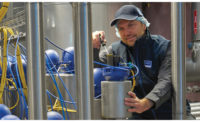DairyFoods.com Exclusive: Dairy processors face a food safety threat
Consistent actions are necessary to reduce foodborne illness risk.

An open-style frame construction can make it easier to sanitize conveyors.
Photo courtesy of SideDrive Conveyor Co.
The threat of contamination looms over dairy processing.
While most processors are working to prevent and eradicate bacteria in plants and work environments that can cause foodborne illness, particularly Listeria, Salmonella, and E.coli, insufficient worker training and faulty operating procedures are making many facilities susceptible to outbreaks, analysts say.
Listeria can be particularly troublesome as the bacteria, which is commonly found in soil, groundwater, rotting vegetation, and animal feces, can survive and even multiply in low temperatures, particularly during storage, and is often difficult to eradicate. Drinking unpasteurized milk is a common cause of infection.

“Safeguarding dairy foods from contaminants is complex due to the perishable nature of products and the large amount of potential contamination sources throughout the production process,” says Vanessa Coffman, alliance director at Stop Foodborne Illness, a Chicago-based public health organization focusing on the prevention of illness and death from foodborne pathogens. Outbreaks often result from employee mistakes, poor management, or disregard for established safety protocols, she notes.
The most successful operators have a strong safety culture that focuses on preventing foodborne illness, says John Butts, founder and principal of Food Safety by Design LLC, a St. John, Ind.-based consulting firm. “Leadership’s commitment to safety, regular communication, and empowerment of frontline staff to report concerns are pivotal,” Butts states.
The lowdown on Listeria
Measures to combat Listeria should be among the top priorities of processors, he says. “Listeria can survive in cold, wet conditions that are typical of dairy facilities, particularly in drains, cracks, floor-wall junctures, deep in equipment, and under equipment,” Butts states. “These and other sanitary design risks must either be eliminated or managed.”
Along with microbial contamination, chemical hazards and poor worker cleanliness habits create food safety risks, says Shipra Pareek, senior account manager, food retail, at NSF, an Ann Arbor, Mich.-based provider of testing, inspection, certification, and advisory services, and digital solutions. “Food safety is paramount in the dairy industry as foodborne illnesses can quickly become widespread,” she notes.
Butts says a multi-faceted approach that combines environmental surveillance, enhanced sanitation, and an increase in staff technical knowledge is necessary to safeguard operations. “Dairy processors can maintain consumer trust by focusing on identifying and mitigating microbial growth niches and harborage sites and leveraging robust monitoring programs,” he states. Physical separation between the areas producing raw and ready-to-eat products is also key for preventing cross-contamination, Butts says.
Many processors, however, are not providing plant personnel with the education that will enable them to recognize and correct risky behaviors and plant conditions, he notes.
This includes demonstrating the proper hygiene procedures, such as frequent handwashing, Pareek says, adding that, “employees must use appropriate sanitation at every step of the production process.”
A well-trained workforce and a positive food safety culture “from the top down and the bottom up,” will reduce incidents, Coffman says. “This culture must be coupled with an eye toward continual improvement, adoption of new technologies, and robust food safety systems.”
Worker training should also be ongoing, says Sara Bratager, senior food traceability and food safety scientist at the Chicago-based Institute of Food Technologists. “This ensures long-term employees retain key knowledge and new hires are quickly brought up to speed,” she states. Butts agrees, noting that “frequent refresher courses ensure staff stays current with best practices.”
Create a clean culture
Perpetually adding to workers’ knowledge should be part of a system that also incorporates an initiative-taking and adaptive approach, Bratager says. “Operators should continuously review and update their food safety plans to reflect emerging risks, evolving market demands, and updated regulations,” she states. “They should also foster a strong food safety culture that emphasizes communication, teamwork, and accountability at all levels of the organization.”

Methods for managing allergen risks should be part of a food safety plan as well, Pareek says, along with measures for maintaining proper temperature controls across the cold chain during transportation, storage, and processing to inhibit bacterial growth. Investing in the latest monitoring and quality control technologies can help address such elements, she states. Processors, for instance, can adopt comprehensive traceability systems that swiftly identify compromised batches in a recall or other food safety incident, Pareek says.
“Environmental monitoring should be a process and not a program,” Butts states. “A successful microbiological monitoring process is not about never finding a positive result; rather, it is about finding positives that drive proactive action.”
Inspecting facilities for pathogens includes taking samples in production areas. The U.S. Food and Drug Administration (FDA) reports that it uses sterile sponges or swabs to determine whether an environment contains harmful bacteria, such as Listeria and Salmonella. The sampling should occur in both food contact surfaces, such as slicers, mixes, utensils, or conveyors, and non-food contact surfaces, like floors, drains, carts, or equipment housing, the FDA states.
“It is important because environmental contamination, absent proper monitoring and controls, may contribute to contamination of finished product,” the FDA notes.
Processors may also need to conduct a root cause analysis and/or take prompt and aggressive corrective action to address contamination and prevent pathogens from becoming established in a plant environment, the FDA states.
“The FDA anticipates that establishments featuring robust environmental monitoring programs will occasionally detect environmental pathogens, and how an establishment responds to such findings is critical,” the FDA notes. “The key objectives are to find the pathogens, if present, through sanitation monitoring programs; to focus on where, when and why the pathogens emerged; and then to implement effective strategies to eliminate them and prevent their recurrence.”
Embracing a predictive mindset and addressing potential issues before they escalate into high-risk situations is also vital, Butts notes. “A well-designed sampling plan should aim to detect organisms and produce data that enables preventative measures,” he says.
Such a “seek and destroy process” that is part of a systematic strategy to locate and mitigate pathogen growth niches and harborage sites can be particularly effective, Butts states. The disassembling of production equipment beyond normal levels for cleaning, along with validating cleaning protocols, and aggressively monitoring products, materials, and facilities, will further reduce food safety incidents, he notes.
In addition, processors can strengthen sanitation protocols by utilizing robust chemicals, Butts says. “Develop procedures to eliminate biofilms, such as with periodic enzyme and infrastructure treatments,” he states. Biofilms are a thin, slimy film of bacteria that adheres to a surface.
“Food safety management involves more than sampling for bacteria and reporting results,” Butts adds. “The responsibility is to guide an establishment from the ‘awareness’ stage to the ‘predictive’ stage. Failure to deploy preventative practices keeps operations in a ‘firefighting’ state, in which processors repeatedly address problems without resolving root causes.”
It can be difficult, however, for processors to leverage the necessary procedures and assets to achieve a higher level of food safety. Many dairy plants have resource constraints, which includes labor shortages and a lack of available funds to upgrade to the latest safety technologies and proven preventive controls, Butts says. “Smaller facilities may struggle with the cost and expertise required to implement advanced environmental monitoring programs and periodic deep cleaning routines,” he states.
Overcoming complacency is another operational hurdle, Coffman says. “The dairy industry has the benefit of pasteurization to kill or inactivate pathogens, but it isn’t a silver bullet,” she states. “If operators aren’t careful, pathogens can enter previously pasteurized products, or the pasteurization process may be incomplete.”
A challenging forecast
Moving forward, processors must brace for further food safety issues because of changing environmental conditions, Bratager says.
“As climate continues to evolve and impact agriculture, there could be additional threats, such as from mycotoxins, which are influenced by temperature and humidity,” she states. Mycotoxins are poisonous substances produced by fungi or mold.

“Warmer temperatures and more frequent extreme weather events, including flooding and drought, create ideal conditions for certain mycotoxins to proliferate,” Bratager says. While mycotoxins have historically been threats in tropical regions, detection is now occurring in other areas, she states.
It is resulting in the need to address such toxins as aflatoxins, a type of mycotoxin that is commonly found in corn and which can be secreted in milk after cows consume contaminated feed, she notes. Exposure to aflatoxins is linked to liver cancer.
While regular audits can help dairy processors determine if their operations are meeting the necessary food safety standards, including those set by the Global Food Safety Initiative (GFSI), plant surveillance should remain vigorous regardless of the findings, Butts states.
The GFSI is a coalition that includes food manufacturers and retailers that is seeking to enhance food safety certification programs and build food safety capabilities across the global food supply chain.
“High scores on GFSI audits do not imply the plant is producing a food-safe product,” he notes. “The actions, or lack of food safety action, from a company’s chief executive officer, leadership team, food safety management, and production operations can result in a lack of preventive controls. In many cases, risk assessments in these facilities are not recognized or ignored.”
Processors also can compromise safety by failing to react to the presence of pathogens after a positive sampling result, Butts states, adding that it is “a common problem.”
While the leveraging of effectual operating procedures and technologies can enable processors to minimize food safety threats, breaches are inevitable, Bratager notes. “Incidents do not always result from negligence,” she states. “Even robust food safety systems can occasionally allow hazardous products to slip through.”
Looking for a reprint of this article?
From high-res PDFs to custom plaques, order your copy today!







